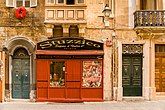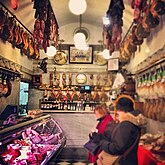Salumeria

A salumeria is a food producer and retail store that produces salumi and other food products. Some only sell foods, while not producing on-site, and some have a restaurant with sit-down service. The salumeria originated in Italy, and dates to the Middle Ages.
Overview
[edit]
A salumeria is a food purveyor and retail store that produces and sells salumi, which are meat products of Italian origin that includes sausages, cold cuts and other foods predominantly made from pork.[1][2] Some salumerie also produce some beef-based products, such as bresaola, a salted beef product, and purvey other food products such as pasta, cheese, preserved foods, anchovies, salt cod, wines, bread and cooked meats.[2][3][4] Some modern salumerie only sell salumi and related products, while not producing products on-premises. Some salumerie also operate sit-down restaurants, such as Sorriso Italian Salumeria in Queens, New York City.[5] Salumeria Biellese is another salumeria in New York City that is well-known, and was established in 1925.[6]
History
[edit]The salumeria originated in Italy and dates to the Middle Ages.[1][7] Historically, salumerie in Bologna, Italy, did not produce their own meats.[1] They selected meats and other products such as pasta, olives and cheeses from local purveyors.[1] These purveyors worked in a guild system that was created by the signori in Bologna, the city's rulers, in a system that dates to the Middle Ages.[1] Purveyors for salumeria products included the salaroli, which controlled the salt industry, who salted the pork, which was then shipped to the lardaioli, a guild that sold the pork.[1] The lardaioli also produced soap and candles from the pork lard they would receive.[1] This guild system was eliminated by Napoléon Bonaparte around the time of the turn of the 19th century.[1]
Gallery
[edit]- Salumerie
-
Foods at a salumeria
-
The store front of a salumeria in Verona, Italy
-
Pasta at a salumeria
-
A salumeria in Valletta, Malta
-
A salumeria in San Gimignano, Italy, established in 1855
-
Interior of a salumeria
See also
[edit]References
[edit]- ^ a b c d e f g h McNaughton, T.; Lucchesi, P. (2014). Flour + Water: Pasta. Potter/TenSpeed/Harmony. p. 232–. ISBN 978-1-60774-471-9. (subscription required)
- ^ a b Ruhlman, M.; Polcyn, B. (2012). Salumi: The Craft of Italian Dry Curing. W. W. Norton. pp. 20–22. ISBN 978-0-393-08416-0.
- ^ New York. New York Magazine Company. 2009. p. 43.
- ^ Hosking, R. (2010). Food and Language: Proceedings of the Oxford Symposium on Food and Cooking 2009. Proceedings of the Oxford Symposium on Food and Cookery Series. Prospect Books. p. 272. ISBN 978-1-903018-79-8.
- ^ Wolff, — Ethan (March 9, 2017). "Sorriso Italian Salumeria". New York. Retrieved March 9, 2017.
- ^ Levine, E. (1997). New York Eats (More): The Food Shopper's Guide To The Freshest Ingredients, The Best Take-Out & Baked Goods, & The Most Unusual Marketplaces In All Of New York. St. Martin's Press. p. 204. ISBN 978-0-312-15605-3.
- ^ Lombardi, M. (2005). Fodor's 2006 Italy. Fodor's Gold Guides. Fodor's Travel Publications. p. 74. ISBN 978-1-4000-1555-9.
Further reading
[edit]- Zimmer, Erin (July 20, 2010). "A Look at Olympic Provisions, Oregon's First USDA-Approved Salumeria". Serious Eats. Archived from the original on 2015-06-21. Retrieved February 5, 2024.
External links
[edit]![]() Media related to Salumeria at Wikimedia Commons
Media related to Salumeria at Wikimedia Commons






